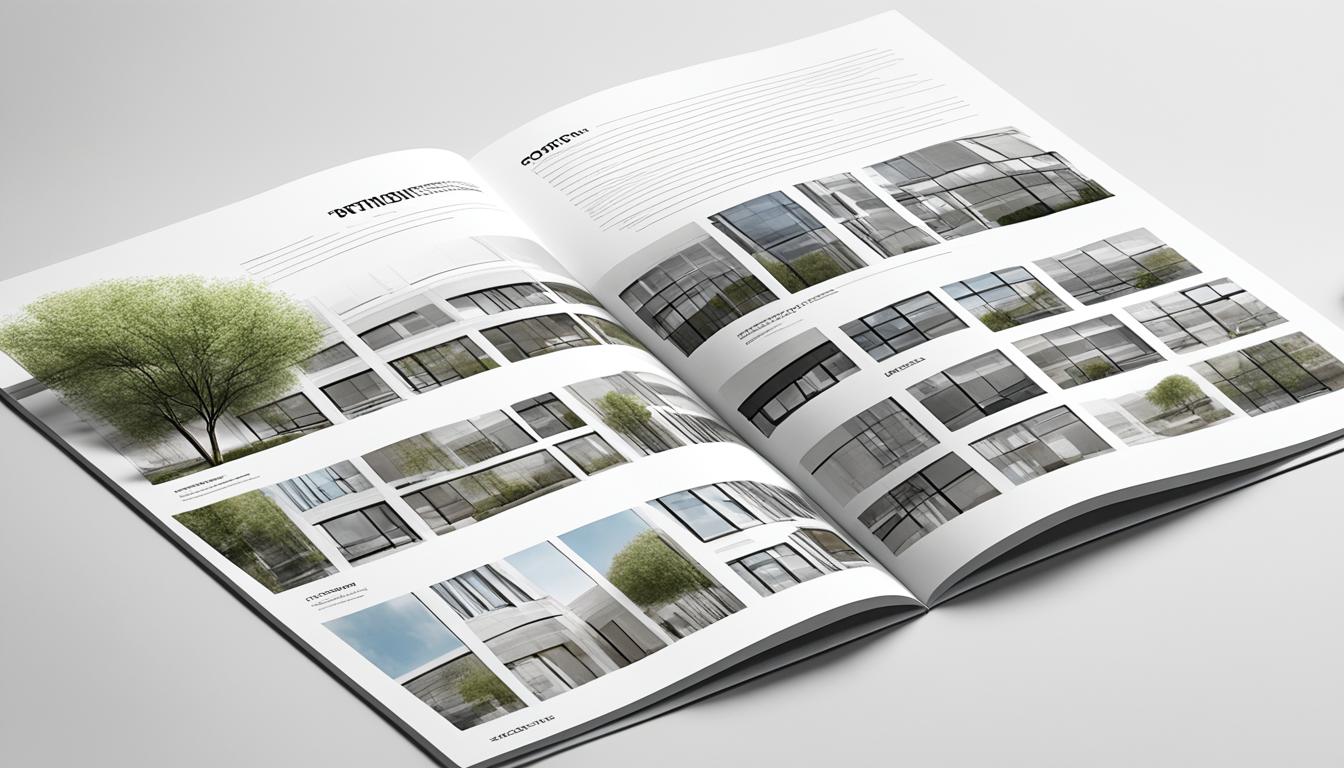In order to stand out as an architect and secure your dream job, you need to create a compelling architecture portfolio that highlights your skills and projects. This article will provide you with expert tips and strategies on how to craft an impressive portfolio that will help you showcase your unique vision and design abilities.
Key Takeaways:
- Include high-quality images and a cohesive color scheme to enhance the visual appeal of your portfolio.
- Provide detailed project descriptions to showcase your skills and highlight your role in each project.
- Consider both physical and digital formats for your portfolio to reach a wider audience.
- Create an online architecture portfolio website to showcase your work and extend your reach.
- Crafting a well-designed architecture portfolio can help you impress potential employers and clients.
The Visual Appeal of the Portfolio Matters
When it comes to creating your architecture portfolio, the visual appeal shouldn’t be overlooked. The design, layout, and overall aesthetic of your portfolio play a crucial role in how your work is perceived. A portfolio that is visually captivating and well-organized can leave a lasting impression on potential employers and clients.
To ensure your portfolio stands out, here are some key factors to consider:
Choose an Engaging Portfolio Design
Your portfolio design should be thoughtfully crafted to showcase your work in the best possible way. Use a layout that allows your projects to flow seamlessly and has a logical progression. Consider incorporating a grid system or a consistent column structure to create a visually pleasing arrangement. Experiment with different design elements, such as typography, spacing, and alignment, to create a unique and appealing look.
Incorporate High-Quality Images
Using professional and high-quality images is essential for capturing the attention of your audience. Ensure that your photos are well-lit, accurately represent your projects, and showcase the details of your designs. By presenting visually stunning images, you can effectively communicate your skills and expertise.
Don’t forget to optimize the size and resolution of your images to ensure fast loading times on digital platforms.
Establish a Cohesive Color Scheme
A cohesive color scheme can enhance the overall visual impact of your portfolio. Choose a palette that complements your work and creates a harmonious atmosphere throughout your portfolio. Consider using colors that align with your personal branding or reflect the style of your architecture.
Ensure an Organized Flow
The organization and flow of your portfolio are crucial for a seamless viewing experience. Arrange your projects in a logical order and create clear sections or categories to guide the viewer. Use headings and captions to provide context and highlight key information. Keep in mind that a cluttered or disorganized portfolio may overwhelm your audience, so aim for a balanced and structured presentation.
A visually appealing portfolio design can captivate viewers and make a lasting impression. Invest time and effort into creating an aesthetically pleasing layout that showcases your work in the best light.
“A well-designed portfolio is like a work of art that leaves a memorable impression on the viewer.” – [Author Name]
By taking the time to carefully consider the visual elements of your portfolio, you can ensure that your work is presented in a way that captivates and impresses.
Examples of Architecture Portfolio Layout Ideas
| Layout Idea | Description |
|---|---|
| Clean and Minimalistic | A simple layout that focuses on showcasing the projects without any distractions. Utilizes ample white space and clear typography. |
| Grid-Based Design | A layout that organizes projects into a grid or mosaic pattern, allowing for a consistent and visually pleasing presentation. Ideal for portfolios with a large number of projects. |
| Storytelling Format | A narrative-driven approach that tells a story through your projects. Each project is presented as a chapter within the portfolio, creating a cohesive and engaging experience for the viewer. |
| Colorful and Vibrant | A bold and eye-catching layout that incorporates vibrant colors and unique design elements. Ideal for portfolios with a strong emphasis on creativity and innovation. |
Showcase Your Skills with Project Details
To make your architecture portfolio stand out, it is crucial to provide detailed descriptions of each project you have worked on. This allows potential employers and clients to gain a deeper understanding of your design abilities and the unique value you bring to the table.
When describing your projects, be sure to clearly outline the goals you aimed to achieve and the challenges you encountered along the way. This demonstrates your problem-solving skills and your ability to navigate complex design requirements.
Highlight your role in each project, emphasizing the specific tasks you undertook and the responsibilities you handled. This helps prospective clients and employers understand your level of involvement and expertise in different areas of architecture.
To capture the attention of viewers, incorporate a variety of visual elements such as images, sketches, renderings, and diagrams. This showcases your creativity and attention to detail, as well as provides a visual representation of your work. Remember to select high-quality images that clearly depict the design process and the final outcome.
Emphasize your ability to create both aesthetically pleasing and functional designs. Talk about how you prioritize the user experience, sustainability, and the overall impact of your architecture on the environment and communities.
Additionally, if you have received any awards or recognition for your projects, make sure to include them. This adds credibility to your work and reinforces your expertise in the field of architecture.

Project Showcase Example:
“In the XYZ project, our goal was to create a sustainable, modern office complex that harmoniously blends with its natural surroundings. We faced the challenge of ensuring a seamless integration of nature-inspired design elements while maintaining functionality and energy efficiency.”
By showcasing your projects with detailed descriptions, visually appealing images, and a focus on functionality and sustainability, you can effectively demonstrate your skills and leave a lasting impression on potential employers and clients.
Choose the Right Medium for Your Portfolio
When it comes to deciding on the format for your architecture portfolio, there are a few key considerations to keep in mind. You’ll need to think about whether a physical or digital medium is more suitable for your specific goals and needs.
Physical Portfolio: A physical portfolio can have a lasting impact in interviews or meetings, allowing you to showcase your work in a tangible and personal way. It gives potential employers and clients a chance to engage with your designs directly, flipping through pages and experiencing the textures and materials used in your portfolio.
Digital Portfolio: On the other hand, a digital portfolio offers the advantage of easy online sharing. With a digital portfolio, you can reach a wider audience and easily share your work with potential employers, clients, and collaborators through email, social media, or a personal website. A digital portfolio also allows for dynamic and interactive elements, such as video walk-throughs or 3D models, which can enhance the viewer’s experience and understanding of your work.
Many architects choose to have both a physical and a digital portfolio, leveraging the unique advantages of each medium. This way, you can cater to different situations and preferences, ensuring that you have a comprehensive representation of your work.
If you decide to create a digital portfolio, it’s highly recommended to consider building an online architecture portfolio website. This will not only provide a professional online presence but also allow you to easily update and manage your portfolio as your body of work expands.
To help you visualize the differences between physical and digital portfolios, here’s a comparison table:
| Physical Portfolio | Digital Portfolio |
|---|---|
| Offers a tangible and personal experience | Allows for easy online sharing |
| Enables tactile engagement with materials | Provides dynamic and interactive elements |
| May require additional effort for transport and storage | Can reach a wider audience with online sharing |
Ultimately, the choice between a physical, digital, or online architecture portfolio depends on your specific goals, target audience, and the experience you want to create. By considering these factors and carefully evaluating your options, you can select the right medium for your portfolio and effectively showcase your unique architectural vision and skills.
Conclusion
Creating a well-crafted architecture portfolio is essential for establishing yourself in the field and attracting potential employers and clients. By following these architecture portfolio tips, you can showcase your skills and highlight your unique vision, setting yourself apart in a competitive market.
First, pay attention to the visual appeal of your portfolio. Use a visually appealing layout, high-quality images, and a cohesive color scheme to create a professional and captivating portfolio design. Remember, the first impression matters.
Next, focus on showcasing your skills through detailed project descriptions. Clearly outline your goals, challenges, and role in each project. Combine visual representations such as images, sketches, renderings, and diagrams to visually communicate your design abilities.
Lastly, choose the right medium for your portfolio. Consider whether a physical or digital format is more suitable for your needs. While a physical portfolio can create a lasting impression in face-to-face meetings, a digital portfolio allows for easy online sharing and wider reach.
With these tips in mind, you can create the best portfolio projects for architects that effectively demonstrate your talents and win over potential employers and clients. Craft your architecture portfolio with care and precision, and watch as your career reaches new heights.
FAQ
How important is the visual appeal of an architecture portfolio?
The visual appeal of an architecture portfolio is extremely important. The layout, design, and overall aesthetic can make a significant impact on how your work is perceived. Using professional and high-quality images, incorporating a cohesive color scheme, and considering the flow and organization of your portfolio are essential.
What should I include in the project descriptions of my architecture portfolio?
When describing your projects in your architecture portfolio, be sure to clearly outline the goals, challenges, and your role in each project. Use a combination of images, sketches, renderings, and diagrams to visually represent your work. Highlight your ability to create both aesthetically pleasing and functional designs.
Should I include awards or recognition in my architecture portfolio?
Yes, it is highly recommended to include any awards or recognition you have received for your architectural projects. This helps showcase your achievements and demonstrates your skill and expertise to potential employers or clients.
Should I create a physical or digital architecture portfolio?
The choice between a physical or digital portfolio depends on your needs and preferences. A physical portfolio can make a lasting impression in interviews or meetings, while a digital portfolio allows for easy online sharing. Some architects opt for both formats to cover all bases. Additionally, consider creating an online portfolio website to showcase your work and extend your reach.
How can a well-crafted architecture portfolio benefit my career?
A well-crafted architecture portfolio can benefit your career by showcasing your skills, highlighting your unique vision, and helping you stand out in a competitive market. It impresses potential employers and clients, and opens doors to new opportunities and projects.
How Can Light Design Concepts Enhance My Architecture Portfolio?
Incorporating innovative ways of harnessing light in architecture can elevate your portfolio. Thoughtful light design concepts can accentuate the unique features of your structures, create captivating visual experiences, and demonstrate your creativity and attention to detail. Whether it’s natural or artificial light, it can greatly enhance the impact of your architectural designs.




